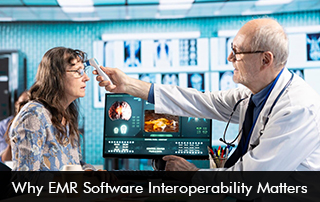EMR Software interoperability ensures that different systems can exchange and interpret patient data accurately, improving care coordination, reducing errors, and enhancing efficiency. In this blog, we’ll explore why EMR software interoperability is crucial for modern healthcare.
What Is EMR Software Interoperability?
Interoperability refers to the ability of different EMR systems to share, access, and interpret patient data across various platforms without losing meaning. It allows healthcare providers to access complete patient records, regardless of where the data was originally stored.
Levels of EMR Software Interoperability
-
Foundational Interoperability – Basic data exchange between systems without interpretation.
-
Structural Interoperability – Data is exchanged in a standardized format, ensuring consistency.
-
Semantic Interoperability – Systems can interpret and use the exchanged data meaningfully.
Without interoperability, EMR operates in silos, leading to fragmented patient care.
The Importance of EMR Software Interoperability
1. Improved Patient Care Coordination
When EMR systems are interoperable, healthcare providers can access a patient’s complete medical history, including lab results, prescriptions, and past treatments. This leads to:
-
Better-informed clinical decisions
-
Reduced duplicate tests
-
More accurate diagnoses
2. Enhanced Efficiency and Reduced Administrative Burden
Interoperable EMR eliminates the need for manual data entry between different systems. Benefits include:
-
Faster data retrieval
-
Reduced paperwork
-
Lower risk of human errors
3. Cost Savings for Healthcare Organizations
Interoperability reduces redundant tests and administrative inefficiencies, leading to significant cost savings. Hospitals and clinics can:
-
Cut down on operational costs
-
Optimize resource utilization
-
Avoid penalties for non-compliance with interoperability mandates
4. Better Patient Engagement
Patients benefit from interoperable EMR software through:
-
Easy access to their health records via patient portals
-
Seamless sharing of data with specialists
-
Improved transparency in treatment plans
5. Compliance with EMR Software Regulatory Standards
Governments and healthcare regulators are pushing for interoperability. For example:
-
The 21st Century Cures Act (US) mandates data-sharing between EMR systems.
-
FHIR (Fast Healthcare Interoperability Resources) standards ensure seamless data exchange.
Non-compliant healthcare providers risk penalties and reduced reimbursements.
Challenges in Achieving EMR Software Interoperability
Despite its benefits, achieving true interoperability in EMR faces several hurdles:
1. Lack of Standardization
Different software vendors use proprietary formats, making data exchange difficult.
2. Data Privacy and Security Concerns
Sharing patient data across systems increases cybersecurity risks, requiring robust encryption and compliance with HIPAA/GDPR.
3. High EMR Software Implementation Costs
Upgrading legacy systems to support interoperability can be expensive for smaller healthcare providers.
4. Resistance to Change
Some healthcare organizations are reluctant to adopt new interoperability standards due to workflow disruptions.
How to Improve EMR Software Interoperability
1. Adopt FHIR and HL7 Standards
Standardized protocols like FHIR (Fast Healthcare Interoperability Resources) ensure seamless data exchange between different EHR software systems.
2. Leverage Cloud-Based EMR Software Solutions
Cloud-based EHR software offers better scalability and integration capabilities compared to on-premise systems.
3. Encourage EMR Software Vendor Collaboration
EMR vendors must work together to develop open APIs (Application Programming Interfaces) that facilitate interoperability.
4. Train Healthcare Staff
Proper training ensures medical professionals can efficiently use interoperable EHR software without disruptions.
5. Implement Strong Data Governance Policies
Healthcare organizations must enforce strict data-sharing policies to maintain security and compliance.
The Future of EMR Software Interoperability
As healthcare becomes more data-driven, interoperability will play an even bigger role. Emerging trends include:
1. AI and Machine Learning Integration
Interoperable EM\HR software will leverage AI to predict patient outcomes and suggest personalized treatments.
2. Blockchain for Secure Data Exchange
Blockchain technology could provide a decentralized, tamper-proof method for sharing EMR data.
3. Expansion of Telemedicine in EMR Software
Interoperability enables seamless integration between EHR software and telehealth platforms, improving remote care.
4. Global Interoperability Standards
Efforts like the International Patient Summary (IPS) aim to standardize EMR data exchange worldwide.
EMR software interoperability is no longer optional—it’s a necessity for modern healthcare. By breaking down data silos, improving care coordination, and reducing costs, interoperable EMR systems enhance patient outcomes and operational efficiency.
Healthcare organizations must prioritize interoperability by adopting standardized protocols, investing in secure technologies, and fostering collaboration between vendors. The future of healthcare depends on seamless data exchange, and EHR software interoperability is the key to unlocking its full potential.







